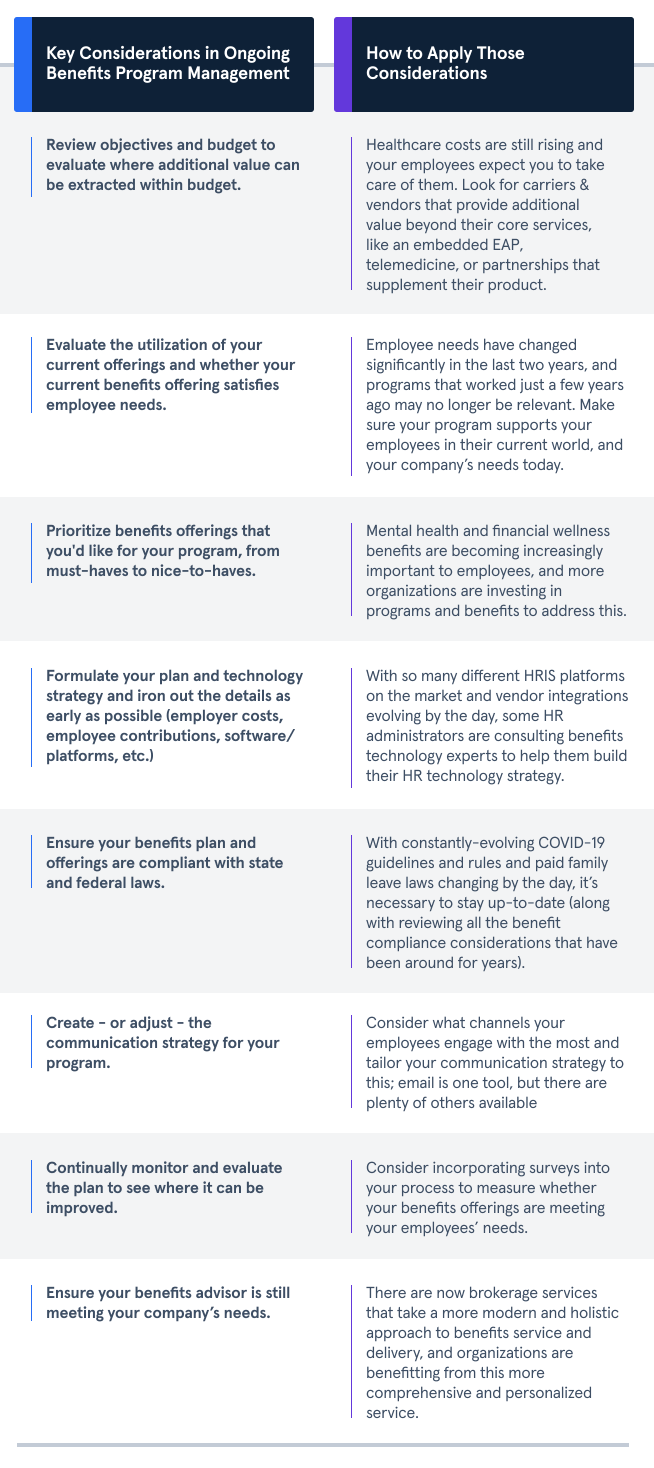
An employee benefits plan that aligns with employee needs is vitally important to acquiring and retaining talent. In fact, a good benefits package increasingly holds more power than high compensation.
By taking the time to craft an up-to-date employee benefits strategy, you’ll attract and keep top talent, reinforce a positive company culture, and create an environment with more satisfied employees overall. Improved productivity, greater engagement, and decreased absenteeism will more than makeup for any additional costs taken on in changing up your offerings.
We’ve outlined eight things that you should consider when reviewing your employee benefits plan during its 12-month cycle, along with how to tie in today’s changing trends to take your benefits strategy to the next level.
8 Key Considerations in Ongoing Benefits Program Management

Consideration 1: Review objectives and budget to evaluate where additional value can be extracted within budget.
The overall cost of healthcare benefits is expected to increase by 5.8% in 2025. As staying healthy gets more expensive, workers are seeking employers who offer benefits packages that will take care of them.
Thankfully, staying competitive doesn’t need to break the bank. Look within your current budget and objectives for places where you might extract a bit more value. Shop for carriers and vendors that are offering more than just core benefits.
Health, dental, and vision are still the foundations of a healthcare package, but many insurance carriers are offering baked-in bonuses and affordable add-ons now:
Embedded EAPs offer a pared-back version of full-service employee assistance programs, generally at a lower cost – they are advertised as ‘free’, but their (greatly reduced) cost is usually included in the overall cost of the package you purchase.
Telehealth and telebehavioral health options are increasingly being offered by carriers and are more in demand.
Many vendors and carriers partner with other companies to offer automatic discounts on outside services that may be useful to your employees, like childcare assistance, grocery deliveries, wellbeing resources, and pet-sitting services.
Consideration 2: Evaluate the utilization of your current offerings and whether your current benefits offering satisfies employee needs.
As Baby Boomers increasingly age out of the workforce and Gen Z joins it, there's been a shift in worker priorities. Assess your offerings, present and potential, to ensure that your program supports the current needs of your employees and your company.
Conduct a utilization review of your company’s benefits, look at your workforce demographics, and survey employees about benefits that most appeal to them. With this data, your company can design a more efficient, appealing, and modern benefits package.
By deprioritizing offerings that are no longer desirable and adding on benefits that appeal to your workforce, you can strike a balance that increases employee satisfaction and reinforces your company culture.
What are a few of the benefits in demand for this year?
Comprehensive mental health offerings, including telebehavioral health, are helping employees combat stress and cutting back on burnout.
More time off: Four-day workweeks are in demand across generational lines, as are more flexible hours, increased or unlimited PTO, and remote work options.
By contrast, in-office conveniences like snacks, free lunches, and coffee bars are less in demand as employees seek the chance to work from home.
Compensation is increasingly less important than overall support. According to Zippia, 41% of employees surveyed would be willing to take a pay cut if it meant more wellness benefits and an environment where they felt better supported.
Consideration 3: Prioritize the benefits offerings you'd like for your program, from must-haves to nice-to-haves.
Take a look at what's trending for this year. Mental health, financial wellness, and even pet insurance are getting a lot of buzz. Now think about your goals for the coming year -- is your business growing? Are you focusing on retention in the face of big changes? Maybe shifting to a remote framework?
With this in mind, you can sort offerings and prioritize ones that work best for your people and your company. Flexibility and remote work options will likely attract more new talent, while mental health services can help to decrease absenteeism. Investing in the right popular programs will increase employee satisfaction while still serving your company’s needs.
Consideration 4: Formulate your plan and technology strategy and iron out the details as early as possible (employer costs, employee contributions, software/platforms, etc.)
As web development trends and technologies advance, so will the online services you use to manage your employees. There are already so many HRIS platforms on the market, and most of them are evolving their offerings by the day.
If staying on top of it all seems impossible, consulting with a benefits technology expert can help you build an efficient and affordable employee benefits technology strategy for your company.
Consideration 5: Ensure your benefits plan and offerings are compliant with state and federal laws.
You are already monitoring long-standing compliance requirements like those set out by the ACA, but make sure that you are also staying up-to-date on the newest laws and regulations at the state and federal level.
Consideration 6: Create (or adjust) the communication strategy for your program
In order to ensure a return on investment, your employees need to know what's available to them and see its value. Don't leave this up to a few emails in the lead-up to open enrollment -- though that's certainly a good start. Have a detailed plan in place to get the word out.
Consider the channels your employees use most when they communicate with you and each other and what messaging they're most receptive to. Keep up communication efforts year-round, be prepared to adapt or change your plan to get the engagement you want, and offer multiple options for education.
Emails, pamphlets, detailed employee benefits guides, in-person and online meetings, even one-on-one discussions are all good avenues to pursue.
Consideration 7: Continually monitor and evaluate the plan to see where it can be improved.
There are some specific processes you can pick up to ensure that you are offering a package that is best meeting your employees' needs:
Issue surveys to employees or offer the chance for open one-on-one discussion. Inquire about perceived value and usage of what’s available to them.
Keep evaluating utilization to see what offerings are popular.
Review employee demographics to get an idea of what might become more or less useful in the future.
Consideration 8: Ensure your benefits advisor is still meeting your company’s needs.
Benefit service and delivery methods are evolving just like every other facet of benefits strategizing. Maybe it’s been a while since you last looked at what brokers and advisors are available.
Modern brokerages are offering more personalized, holistic approaches to service and delivery. Making sure your company has the right broker, one who works with you to see that your employees are truly supported, has far-reaching benefits.
So, as part of your overall strategy, examine how your current benefits advisor serves you, and don’t hesitate to build a pool of potential new candidates. You may find something that more comprehensively serves your company’s needs.
At Bennie, our app, consulting services, and marketplace are designed to help employers create a better benefits experience for their employees. Our personalized benefits and HR tech consulting services provide you with the right foundation, strategy, and tools to develop a more competitive benefits offering.
Wrapping Up
The importance of a good employee benefits plan cannot be understated, both because of the benefits it provides and your cost investment as an employer. Keep our eight key points in mind when planning.
By staying up to date, researching your options, and communicating with your employees, you will be better able to craft an employee benefits strategy that keeps your employees happy and your company competitive.







